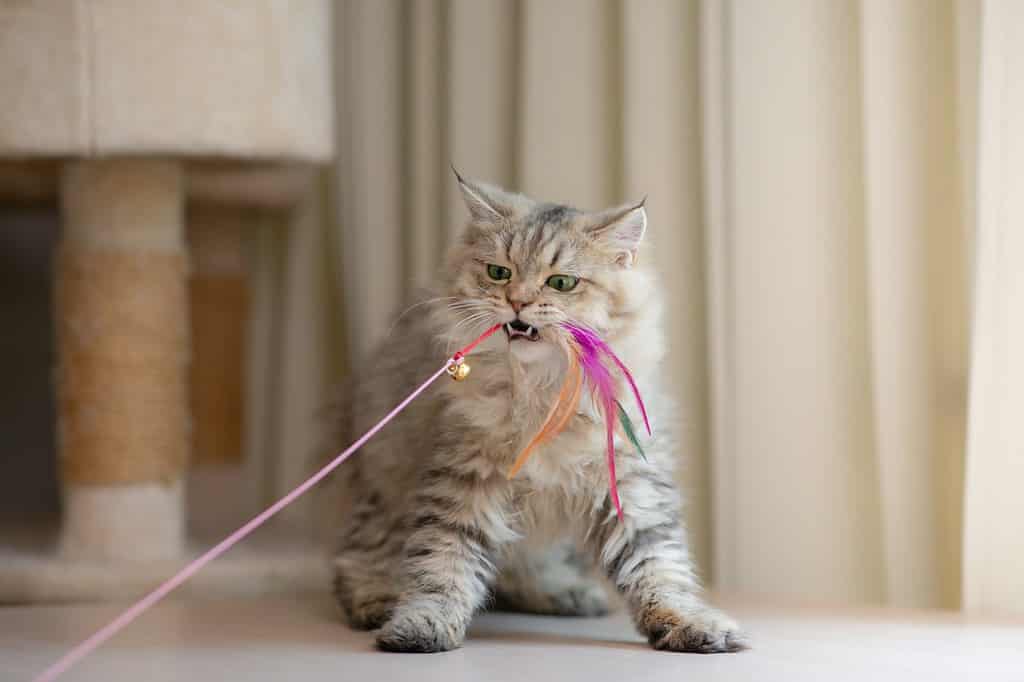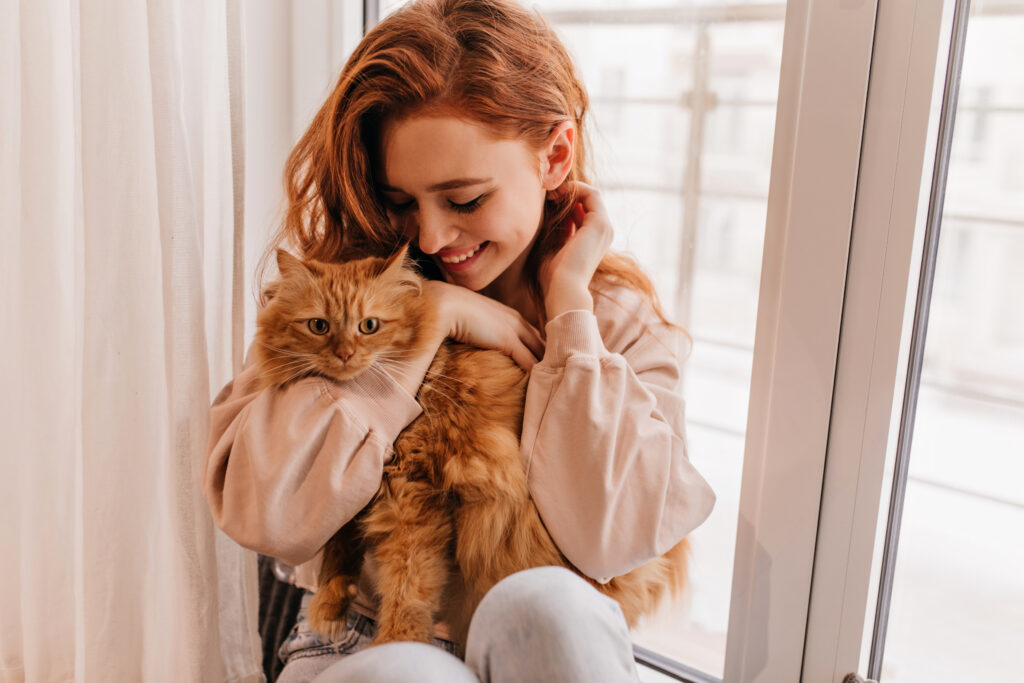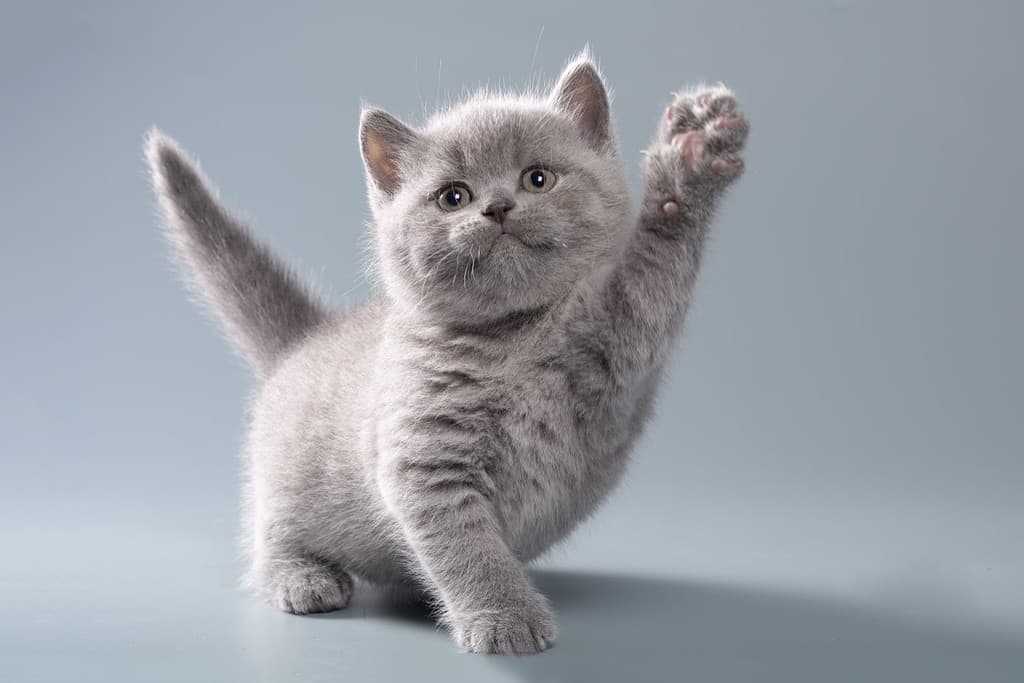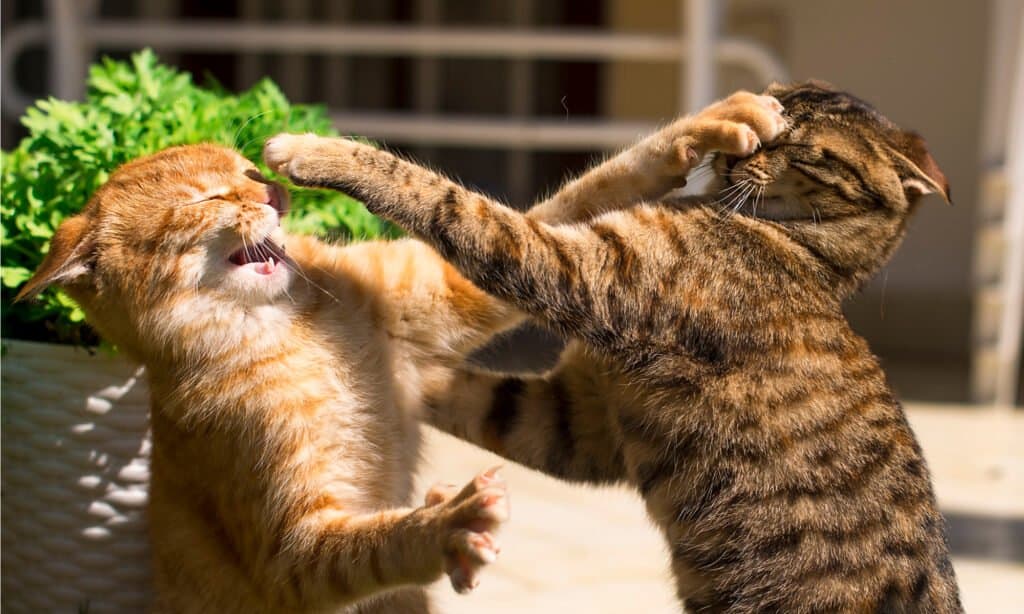As feline pet owners, we love to watch our cats play. Who could resist those cute butt wiggles, or pounces, or cat zoomies? But when playing has gotten out of hand, our cats can become vicious. Read this article to discover how to tell if your cats are playing or fighting and which signs to look out for.
How Can I Tell If My Cats Are Playing?
If you’ve ever seen a kitty play, you know firsthand that it can get intense. Signs that your cats are playing include:
- Their bodies will be calm.
- They may try to roll around the ground, bed, or area where they are playing.
- Trilling. Trilling is a noise that cats make that allows them to show that they are enjoying their playtime.
- The movements are not stiff, rigid, or threatening. When your cats play, they move with a fluid, gliding-like motion.
- Your cat might also chirp when they are playing.

Kitties will chirp when they play to express that they are having a great time.
©ANURAK PONGPATIMET/Shutterstock.com
How Can I Tell If My Cat Is Having Fun While Playing?
If your cat is enjoying playtime, they will display the following signs:
- Their tails will be pointed straight in an upward position. Plus, their tail will have a slight bend at the end of it.
- While your kitties are playing, one may approach you and attempt to get you to join in the fun.
5 Tips to Ensure a Happy Play Time Experience
Ensuring that your kitties are having a grand time playing doesn’t have to be dull. Here are five tips to ensure that your cats enjoy their playtime.
- If you have indoor cats, make sure your home has enough room for them to run, hop, and wrestle in.
- If you have indoor cats, make sure that your home has enough room for them to run, hop, and wrestle in.
- Before playtime, be sure to remove toxic cleaners, glass objects, and other items that can injure your felines.
- Create a room or space specifically for playtime. You’ll want to include items that they can bat and pounce on, such as catnip toys, toy mice, etc.
- If you have an obese cat, a cat with high blood pressure, or a cat with other medical issues, you’ll need to supervise its playtime to make sure it doesn’t exhaust itself.

If you have indoor cats, make sure that there is enough room in your home to provide a space to run, hop, and wrestle in.
©Look Studio/Shutterstock.com
How Much Exercise Should My Cats Receive During Playtime?
Exercise is an important part of life for humans and kitties. Ideally, you should provide about 20 to 60 minutes of exercise every day. However, it should be broken down into 4 segments of 15 minutes per segment of playtime. Cats have small circuits of energy, followed by a longer period of rest.
Are There Benefits to Playtime for My Cats?
Yes! Many of these benefits go far beyond just providing exercise. These benefits include:
- Playtime creates a safe way for your cat to embrace their hunting instincts.
- Relieve anxiety and depression.
- Provide challenges that help stimulate your cat’s body and mind.
- Playing with your cat can improve your connection. It builds trust and is joyful for both the pet and the owner.
How Can I Tell If My Cats Are Fighting? 8 Things to Watch Out For
While playtime can get rough for some kitties, knowing the warning signs to detect if your cats are playing or fighting is important. Here are a few signs that your kitties are in an argument:
1. Flattened Ears
Your cat’s ears will be pinned to their heads or pointed in a backward direction. Their ears can also appear as if they are glued to the top of their head from flattening so much. This body language signifies anger, irritability, or fear.
2. Dilated Pupils
When your cat’s eyes are dilated, it can represent a few things. For example, dilated pupils can mean that your cat is excited to play. On the other hand, it can also represent that they are ready to battle your other cats.
3. Tail Pinning, or Flicking
A tail that is pinned between their legs can signify a worried cat. On the other hand, if your feline’s tail is flicking back and forth quickly, they may be trying to tell you or the other cat that they are flustered.
4. Arched Back
If your cat arches their back and puffs up their fur, it is not a sign that they wish to play. Rather, they are trying to make themselves appear bigger to ward off other kitties. Or, it could be telling you that something has startled them.
5. Growling
Felines use many different variations of verbal communication. Depending on the situation, it could mean different things. For instance, if your cat is growling, they are attempting to tell your other kitties that they don’t like what they do.
6. Hissing
Similarly to growling, hissing is often a sign of an unhappy cat. If your cats are playing and suddenly you hear your cat hiss at the others, it could mean that they are ticked off and want to be left alone.
7. Staring
When your feline has a staring contest with another cat, it can mean a few things. First, your cat is trying to assert dominance with the other kitty. Secondly, they are attempting to aggressively protect their litter box, toy, or bed.
8. Yowling
If your cat lets out a long meow, they are yowling. Yowling is a form of verbal communication between other cats and their owner. Yowling either means that they are trying to locate you, they are stuck somewhere, or they are worried.

Dilated pupils are a sign that your cat may be in fighting mode.
©OksanaSusoeva/Shutterstock.com
Why Is My Cat Acting Aggressive?
Numerous factors, such as hidden health issues, fear, abuse, or uncertainty of other pets and people, can cause aggression in cats. In the next section, we’ll examine four types of cat aggression in detail.
4 Types of Cat Aggression
Unfortunately, it is hard to pinpoint exactly why your cat may be showing signs of aggression. However, these four examples below can help you gain some understanding.
1. Fear Aggression
Cats who have trauma after unpleasant situations and circumstances may display fear and aggression. Fear aggression is any time your cat displays hostility due to feelings of fear or entrapment.
2. Maternal Aggression
Shortly after your cat has given birth, they may display signs of hostility towards you or another cat. However, the aggression should be gone after their babies are weaned from nursing.
3. Play Aggression
If you saw felines bite, pounce, or stalk during play, you know that playtime can get wild. On the contrary, if playtime overwhelms your cat, they are liable to turn playtime into an all-out brawl.
4. Territorial Aggression
Similar to other animals and people, cats can develop protection over their homes, beds, and toys. This is otherwise known as territorial aggression. Cats will swat, hiss, or even growl if they feel that their territory is in danger of being taken away from them. They can also become aggressive in their territory if someone they do not know tries to play with their toys.

Territorial aggression is when a cat becomes protective over their home or toys.
©scaliger/iStock via Getty Images
How to Prevent Feline Fighting
If you are concerned that your cats may end up in a brawl, there are a few things that you can do to deter them. Here are a few ways to prevent catfights (and we don’t mean the ones you see on TV).
1. Spay or Neutuer Your Cats
One of the common reasons that cats will fight relates to their reproductive organs. Male cats will fight with other unfixed males. Moreover, female cats are more prone to having litters, which will raise their chances of developing maternal aggression over their litter.
2. Provide Numerous Cat Hideouts
As you might have guessed, cats lash out when scared or cornered. Providing boxes, beds, and houses where they can hide when startled can help deter them from becoming violent.
3. Make Sure Every Cat Has Their Supplies
As mentioned above, kitties can be very territorial. Therefore, it is wise to invest in supplies that will be enough for each cat. When cats feel they are low on resources, they are likely to lash out and fight with other cats over them. A good rule of thumb is to ensure that each cat has a supply of food bowls, toys, litter boxes, beds, and hideaways.
4. Use Pheromone Spray
Pheromone spray can help felines feel a bit more secure. Spritz a pheromone spray to help reduce the chances of aggressive behavior.
5. Keep Felines Apart During Meals
Kitties can be protective of their food. So, it would be smart to ensure that each cat’s dishes are spaced apart enough to provide this protection.

Keeping your cats apart during feeding times can help prevent food aggression.
©chendongshan/iStock via Getty Images
3 Things You Should Never Do If a Cat Fight Breaks Out
Cat fights can be frightening. But there are some things you should avoid doing to prevent fights from getting worse.
1. Never Let a Fight Go On
If a fight becomes increasingly violent, it is strongly recommended that you stop the fight before blood is shed. Cats will use fighting as a means to end a disagreement rather than to solve it. Despite trying to resolve a catfight, do not put yourself in between them. Rather, use a loud noise or a quick motion to distract your cats.
2. Do Not Comfort Them
Smothering a cat during or after a fight is not recommended. Instead, give your kitty time to cool down. They’ll come around when they are ready.
3. Do Not Use Negative Reinforcement
Yelling at or punishing your cat for unwanted behavior may be tempting. However, this can make your cat more aggressive.

Instead of allowing your cats to fight, try to distract them with a sound or movement.
©Mariya Ilmaz/Shutterstock.com
Summary of 8 Ways to Tell If Your Cats Are Playing or Fighting
Are your cats playing or fighting? Chances are they are playing and get a little rough. Remember to be aware of the signs of aggression to prevent playtime from becoming a kitty fight club.
| Signs Your Cat Is Playing | Signs Your Cat Is Fighting |
| Their tail is straight with a slight curve at the end. | Their tail is between their legs. |
| They are making trill noises. | Your cats are hissing or growling. |
| Rolling around on the ground, bed, or play area. | Staring down your other cat with their ears pinned back. |
| Graceful, fluid, and smooth movements as your cats play with one another. | Fur is puffed out, back is raised, and your kitties are moving very stiffly. |
| Running around the house. | Your felines are Stalking your other kitties from one specific area. |
| Chirping at other kitties, pets, or people in the house. | The tail is flickering back and forth in a rough movement which represents aggression. |
| Chasing toys around the house. | Guarding toys in one corner of the room while growling at your other cats. |
| Hiding and jumping out at other kitties. | Isolating from other cats. |
The photo featured at the top of this post is © Anna Krivitskaya/Shutterstock.com
Thank you for reading! Have some feedback for us? Contact the AZ Animals editorial team.







